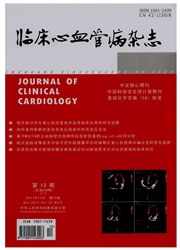

 中文摘要:
中文摘要:
目的:探讨冠状动脉(冠脉)粥样硬化的危险因素对心肌桥和无心肌桥患者在冠脉粥样硬化形成过程中影响的差异。方法:回顾性分析心肌桥合并冠脉粥样硬化患者78例(A组),无心肌桥的冠脉粥样硬化者73例(B组),再进一步将A组根据心肌桥在收缩期的狭窄程度分为A1组和A2组,比较A组与B组、A1组与A2组的冠脉粥样硬化危险因素的差异。结果:A与B组、A1与A2组在年龄、胸痛、BMI等方面差异无统计学意义。A与B组在餐后2h血糖、低密度脂蛋白等方面差异有统计学意义(P〈0.05);A1与A2组在收缩压、低密度脂蛋白等方面差异有统计学意义(P〈0.05)。结论:心肌桥者因其特殊结构而较无心肌桥者更易受危险因素的影响而形成冠脉粥样硬化,更早干预和更严格控制心肌桥者的危险因素可能有利于预防和延缓冠脉粥样硬化的形成和进展。收缩期狭窄率越重其所需形成粥样硬化的危险因素越少,心肌桥收缩期狭窄程度可能是粥样硬化过程中重要的影响因素。
 英文摘要:
英文摘要:
Objective: To explore the influence of risk factors for coronary atherosclerosis on the process of for- mation of coronary atherosclerosis between the patients with myocardial bridging and without myocardial bridge. Method:Seventy-eight cases with coronary artery atherosclerosis and myocardial bridge were included into group A, 73 patients with coronary atheroselerosis and myocardial bridging were included into group B. Group A then divided into group A1 and group A2 according to the severity of stenosis. The different influence of coronary ath- erosclerosis risk factors between the group A and B, group A1 and A2 were compared. Result.. There was no sta- tistical significance in age, chest pain, BMI and other aspects between Group A and Group B, Group A1 and Group A2. 2hPG, low-density lipoprotein and other aspects between group A and group B were statistical differ- ent (all P〈0.05) ; systolic blood pressure, LDL-C and other aspects between group A1 and A2 were also statisti- cal different (all P〈0.05). Conclusion.. Patients with myocardial bridge are more susceptible to the formation of risk factors for coronary atheroselerosis than those without myocardial bridge. Earlier intervention and tighter con- trol for those with myocardial bridge may benefit for preventing and delaying formation and progression of coro- nary atheroselerosis. The heavier systolic narrow, the much less risk factors in the formation of atherosclerosis. The degree of systolic stenosis of myocardial bridge may be an important factors in the process of atherosclerosis.
 同期刊论文项目
同期刊论文项目
 同项目期刊论文
同项目期刊论文
 期刊信息
期刊信息
